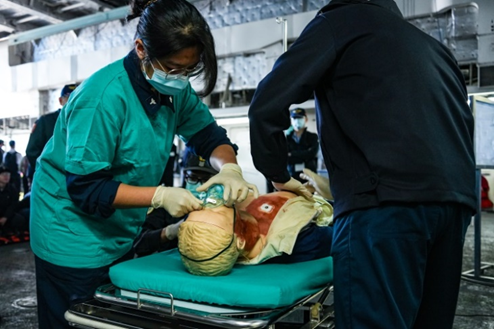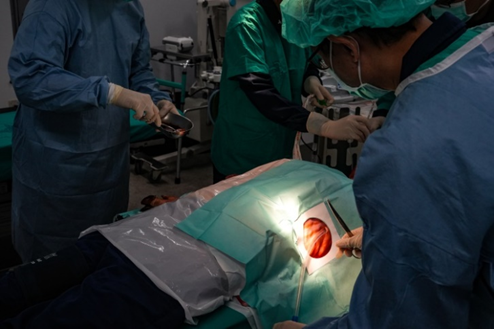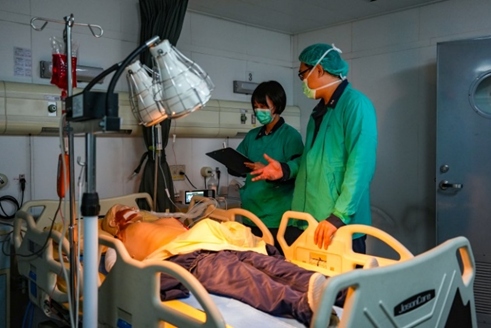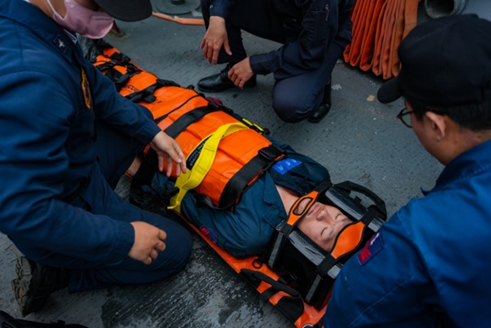3.1 Military Medicine
Military Medicine
As the designated hospital for the Fourth Theater of Operations (covering Tainan, Kaohsiung, and Pingtung), Zuoying Armed Forces General Hospital actively develops diving medicine and burn care center in response to military strategic needs. In addition to strengthening the hospital’s capacity to provide wartime medical support, it offers advanced medical services to the general public in times of peace, as well as to enhance the nation’s disaster response system, fully embodying the policy goal of ‘integration of military and civilian forces and sharing of resources’.
Looking ahead, the hospital will continue to refine its medical technologies and management capabilities, improve the quality and capacity of care, and uphold the spirit of ‘protecting the nation through military health’. It remains committed to safeguarding the health and well-being of both military personnel and local civilians in the region.
Diving Medicine
Zuoying serves as the key naval base in Taiwan, and the Diving Medicine Department of the Zuoying Armed Forces General Hospital was originally established to support the formation of the military’s diving (submarine) units. Its mission is to provide medical support for underwater operations such as underwater assault, demolition, mine clearance, and rescue, all of which carry risks such as decompression sickness (the bends), pulmonary overinflation syndrome, and barotrauma. To address these challenges, the hospital established the nation’s only simulated deep-sea diving training chamber in 1976, positioning itself as a pioneer in diving medicine and hyperbaric oxygen therapy in Taiwan.
After years of development, the Diving Medicine Department was upgraded from a division to a full department in 2005. Its services expanded from exclusively supporting naval divers to also serving civilian divers and patients requiring hyperbaric oxygen therapy. In 2014, it was awarded the Symbol of National Quality (SNQ) certification, recognizing its outstanding professional performance in the fields of diving medicine and hyperbaric therapy. In 2025, the department will be further upgraded into the Diving Physiology Training Center, with the goal of transforming into a certified institution for diving medicine, enhancing its saturation diving training capacity, and expanding its role in diving medicine.
The hospital will continue to deepen its expertise in diving medicine and hyperbaric oxygen therapy, actively promoting research and applied development in these fields. It is committed to delivering high-quality clinical services and professional education and training, with the goal of becoming a key national hub and model center for diving medicine and hyperbaric therapy in Taiwan.

In order to minimize non-combat attrition during wartime and maintain operational force power, while ensuring mobility in emergency medical response during peacetime, the Diving Medicine Department at our hospital maintains a 24/7, year-round standby team. The hospital is equipped with the largest hyperbaric oxygen chamber in Taiwan, a multi-person treatment chamber that features a unique ‘twin-chamber integration and emergency transfer’ capability, which is unavailable in other medical facilities. This system allows decompression sub-chambers aboard naval vessels to transport injured personnel by land, sea, or air to the hospital, where they can be transferred into the main treatment chamber, enabling immediate and continuous care for patients suffering from severe decompression sickness.

Commissioning of the Diving Physiology Training Center
In line with the ongoing implementation of ‘Indigenous National Defense Program’ under self-reliant national defense policy, the Medical Affairs Bureau of Ministry of National Defense has invested resources into the construction of the Diving Physiology Training Center at our hospital in order to strengthen the combat capability and logistic support system of submarine troops and underwater operation units. The center was officially completed and commissioned in 2024. The center is equipped with Taiwan’s first saturation diving training chamber, a computed tomography scanner (CT scanner), and 30 other advanced devices, marking a new milestone in the nation’s capability for indigenous saturation diving training. This advancement significantly enhances the navy’s overall capacity for underwater operations and rescue missions.
Saturation diving is a critical technique specifically designed for long-duration deep-sea operations. The principle involves divers breathing a helium-oxygen gas mixture, allowing the inert gases in their body tissues and fluids to become fully saturated. This enables the body to withstand the high-pressure conditions of deep-sea environments effectively. By combining pressurized living chambers with diving bells, saturation diving allows divers to remain underwater and perform operations continuously for several days or even weeks, ensuring both mission safety and operational efficiency. This technology is widely used in both military and civilian fields, including submarine rescue, underwater construction, marine resource exploration, and oceanographic research, providing a stable and reliable support system for deep-sea missions. Unlike traditional deep diving, which requires stage-by-stage decompression after every dive, saturation diving only requires one extended decompression period at the end of the mission—potentially lasting several days. This significantly simplifies the operational process, reduces decompression frequency, and lowers the risk of decompression sickness for divers.
 潛水生理訓練中心大樓
潛水生理訓練中心大樓 飽和潛水訓練艙
飽和潛水訓練艙Burn Center
In the early years, an explosion at a naval ammunition depot, along with concerns over large-scale burn injuries caused by wartime firearm attacks, bomb blasts, and incendiary weapons, highlighted the critical role of burn treatment in military medicine. Recognizing the significant impact of such injuries, our hospital was tasked with establishing a burn ward, which was later expanded into the first burn center in southern Taiwan.
The center is staffed by a professional team of burn specialists and trained nurses, who are responsible for a wide range of medical procedures, including infection control, skin grafting, and wound care. The center has achieved significant clinical outcomes, with numerous research publications featured in professional medical textbooks, demonstrating its high standard of care. In addition, the hospital has integrated resources across multiple departments to establish a comprehensive burn care team, providing holistic treatment for patients, from emergency care and surgery to rehabilitation, showcasing its strong capacity in interdisciplinary medical integration.
The hospital has actively fulfilled its social responsibility by participating in the emergency care and medical support of many major disasters over the years, including TransAsia Airways plane crash and Kaohsiung gas explosion in 2014, and Formosa Fun Coast dust explosion in 2015, where a large number of healthcare professionals were mobilized and fully committed to the emergency care of burn patients, demonstrating a high level of professionalism and a strong sense of duty.

The Leading Center for Critical Burn Care in Southern Taiwan
Since 2017, the Burn Center has been certified with SNQ. Over the years, it has undergone multiple upgrades in infrastructure and medical equipment as well as renovation to provide a safe, comfortable, and high-quality treatment environment for burn patients. The center actively collaborates with domestic and international institutions and has established a long-term sister burn center partnership with the Jacee Burn Center in North Carolina, USA. It also co-hosts annual clinical reports and academic exchanges with the Childhood Burn Foundation of the Republic of China and three designated burn hospitals in northern, central, and southern Taiwan to continuously advance clinical techniques and improve medical quality.
In terms of equipment, the hospital has introduced advanced life-support systems including Extracorporeal Membrane Oxygenation (ECMO), Intra-Aortic Balloon Pump (IABP), Pulse-induced Contour Cardiac Output (PiCCO), and Continuous Renal Replacement Therapy (CRRT). These technologies significantly enhance the treatment capabilities for patients with severe burns. The center treats an average of 50 to 70 patients with extensive burn injuries each year, serving as a stable and advanced burn care resource for the southern Taiwan region.
In line with future military policy and budget planning, the hospital plans to expand the Burn Center by constructing dedicated operating rooms and upgrading all inpatient units to private rooms, each equipped with hydrotherapy facilities. In addition, dialysis-capable equipment will be installed to further enhance the effectiveness of burn treatment and improve the overall quality of care.

Burn Injury Prevention Education
In addition to providing comprehensive inpatient medical care, the Burn Center is also committed to burn prevention and health promotion. The team actively engages in educational outreach across schools, communities, and workplaces to raise awareness among child caregivers and the general public regarding proper burn prevention and first aid practices. These efforts also aim to reinforce the understanding of fire and electrical safety, as well as burn prevention and emergency response among elementary and junior high school students and communities. In 2024, the center organized 10 burn prevention education sessions, reaching a total of 750 participants. Since 1996, the hospital has collaborated with the Childhood Burn Foundation of the Republic of China to host annual summer camps for children with burn injuries. Through outdoor activities and group interaction, the camps help young burn survivors rebuild self-confidence, enhance social skills, reintegrate into school life, and support their holistic physical and psychological recovery.

Combat Casualty Care
Providing medical support during wartime is one of the core missions of the Zuoying Armed Forces General Hospital. In order to ensure rapid and effective medical response in times of conflict, the hospital actively participates in various military exercises and training programs during peacetime. Concurrently, the hospital continually enhances the quality of its medical services across specialized fields, thereby strengthening the nation’s overall capacity to respond to major disasters and emergencies.
During regular missions, the Zuoying Armed Forces General Hospital also serves as a designated emergency medical response hospital within Kaohsiung City’s Emergency Medical Network. It has been appointed as a specialized facility for treating burn injuries and chemical burns, demonstrating its strong capabilities in emergency response and care. Besides receiving critical patients transferred and coordinated through Kaohsiung City’s Emergency Medical Consultation Center, the hospital actively provides both pre-hospital and in-hospital emergency medical services during large-scale events and unexpected incidents. This reflects the robust capacity of the military medical system in safeguarding public health and responding to disasters.

Mass Casualty Rescue Drill
Aiming to enhance the operational effectiveness of ‘Military Regional Medical Responsibility System’ under the Ministry of National Defense, Zuoying Armed Forces General Hospital conducts regular mass casualty drills each year to comprehensively strengthen the ability to respond to and deal with unexpected mass casualties. The hospital is committed to maximizing the effectiveness of medical resources to ensure rapid response and effective rescue in case of wartime or major disasters, and to safeguard the lives of both military and civilians.
When the Duty Officer or Emergency Department receives information regarding a major disaster or urgent medical rescue need within the hospital’s designated responsibility area, and if it is anticipated that a large number of casualties will be transported in a short period, and the projected patient load exceeds the department’s capacity (e.g., more than 15 casualties or over 3 critical cases) after evaluation by Emergency Department Director, the hospital will immediately activate its emergency staffing system and establish the Hospital Emergency Incident Command System (HEICS). Based on the disaster notification details, the system will rapidly convene support departments and medical staff, prepare essential medical supplies, blood (plasma) inventory, and beds. Simultaneously, all related support units will be notified to complete readiness procedures.
At the emergency entrance, a triage area is established where patients are categorized and directed to the designated treatment zones based on the severity of their injuries. Medical team leaders in each area report every 30 minutes to the on-site commander (the Emergency Department Director), providing updates on treatment progress and patient conditions. These updates assist the command center in maintaining real-time awareness of the overall emergency response and, when necessary, notifying relevant authorities such as the Medical Affairs Bureau, Ministry of National Defense, and local health departments.
In case of wartime or major disasters that require a large number of patients who cannot be transferred to other hospitals, the hospital has preemptively planned to set up temporary beds in the corridors of Ward 3-9 and nursing home. This setup can accommodate up to an additional 90 patients, demonstrating the hospital’s strong role as a reliable support hub in both peacetime-to-wartime transitions and large-scale emergency responses.

‘Resilient Nation Medical Preparedness Program’
In response to the goal of building a robust democratic society advocated by the ‘Whole-of-Society Defense Resilience Committee’ of Office of the President, Executive Yuan has launched the ‘Resilient Nation Medical Preparedness Program’ (2024–2027), led by the Ministry of Health and Welfare. The program integrates resources from agencies such as National Fire Agency of Ministry of the Interior and Medical Affairs Bureau of Ministry of National Defense to conduct cross-sector emergency medical training and strengthen horizontal coordination among local governments, fire departments, medical institutions, and military hospitals. The ultimate goal is to establish a national medical defense system with integrated mobilization and high-efficiency response capabilities, ensuring continued operation of critical national functions during disasters.
Zuoying Armed Forces General Hospital is positioned as a regional teaching hospital with medical center-level quality. It is currently recognized by the Ministry of Health and Welfare as a ‘moderate-level emergency responsibility hospital’, and is actively preparing for assessment as a ‘partial heavy-duty’ emergency hospital to continuously enhance its response capacity and emergency care capabilities. In alignment with the policy direction of the ‘Resilient Nation Medical Preparedness Program’, the hospital is also planning to upgrade its medical facilities and expand its space, and build a modern underground medical building that is both resilient and agile. In addition to providing a full range of services such as surgery, emergency care, imaging, specialized treatment and inpatient care during normal times, it is also equipped for rapid conversion in wartime or during major disasters, allowing for immediate activation of underground contingency hospital beds, delivering stable and efficient emergency medical support and serving as a critical stronghold in safeguarding the health of military personnel and civilians, as well as national security.
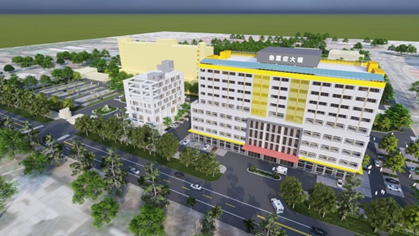 新建醫療大樓模擬圖
新建醫療大樓模擬圖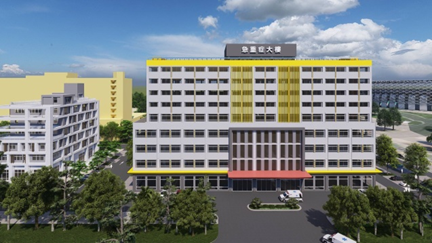 新建醫療大樓模擬圖
新建醫療大樓模擬圖Combat Readiness Preparation
To address situations during wartime operations where second-level medical support (e.g., casualty evacuation control stations or field medical stations) is insufficient, roads are blocked preventing timely evacuation, or nearby emergency responsibility hospitals are overwhelmed, Zuoying Armed Forces General Hospital, under the guidance of the Medical Affairs Bureau of Ministry of National Defense, has established Forward Resuscitative and Surgical Detachment (FRSD), which consists of one emergency physician, two surgeons, one anesthesiologist, four nurses, two medical support staff, with a total of 10 people.
This team possesses high mobility and rapid deployment capability, enabling it to perform initial surgical interventions and stabilize injuries in frontline environments. Even when immediate evacuation is not possible, severely injured personnel can still receive critical emergency care at the earliest possible moment, effectively extending the golden hour for rescue and increasing survival rates. In 2024, the hospital successfully conducted a shipboard surgical drill in cooperation with the Pan Shi-class fast combat support ship, demonstrating FRSD unit’s training effectiveness and combat readiness, as well as showcasing the hospital’s ongoing commitment to strengthening its critical support role in military medicine.
In addition, considering that Taiwan’s blood supply mainly relies on centralized coordination by blood donation centers, a surge of donors during wartime could potentially overwhelm the existing blood collection and storage capacities, which may result in delays or shortages in blood product supply. In order to reinforce a self-reliant wartime medical support system, Zuoying Armed Forces General Hospital, under the guidance of Medical Affairs Bureau of the Ministry of National Defense, is currently planning to collaborate with other military hospitals to jointly establish regional blood donation centers to progressively build an exclusive emergency blood supply system for the armed forces, ensuring timely and stable access to essential blood products during wartime, and enhancing the overall medical response and combat support capabilities.
前進外科小組執行艦艇醫療艙間手術演練
